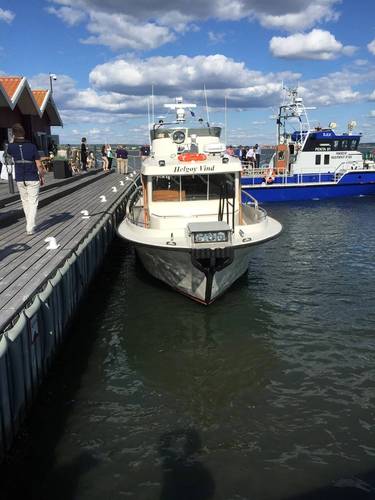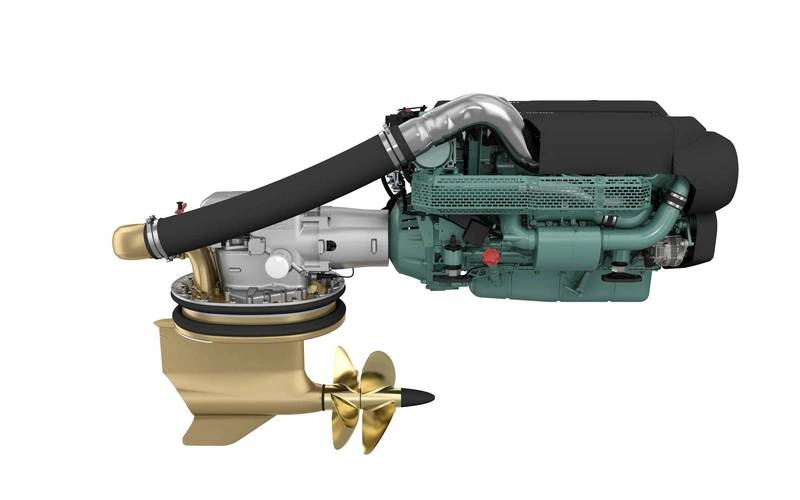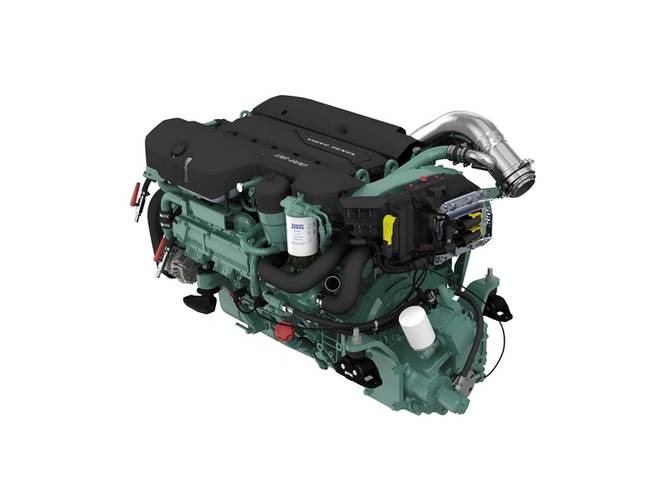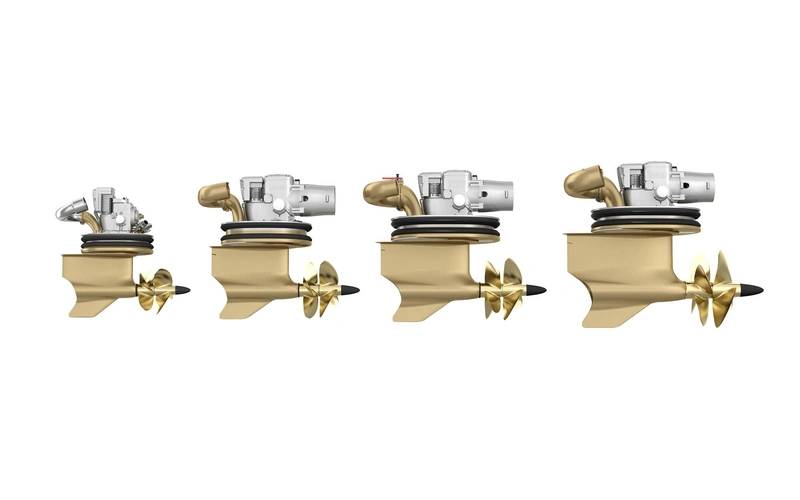Volvo Penta Debuts New D8 Diesel Engine & IPS
Ever since the global financial meltdown of 2008 briefly crippled the world leisure boat market, Volvo Penta adopted a strategy to increase its commercial market share with its family of innovative propulsion systems and controls. Last week off the west coast of Sweden, Maritime Reporter & Engineering News got up close and personal with the new D8 diesel and IPS15 pod, as well as the full range of command and control products courtesy of a day of test drives at Krossholmen, Volvo Penta’s Global Marine Testing Center. By Greg Trauthwein
(All photos courtesy of Greg Trauthwein or Volvo Penta)
Ever since the global financial meltdown of 2008 briefly crippled the world leisure boat market, Volvo Penta adopted a strategy to increase its commercial market share with its family of innovative propulsion systems and controls. Last week off the west coast of Sweden, Maritime Reporter & Engineering News got up close and personal with the new D8 diesel and IPS15 pod, as well as the full range of command and control products courtesy of a day of test drives at Krossholmen, Volvo Penta’s Global Marine Testing Center.
By Greg Trauthwein
In the middle of a financial storm such as the one that swept the globe in 2008/2009 it is not easy to see a ‘silver lining.’ However Stefan Carlsson, Volvo Penta’s Marine Diesel segment head said that the dramatic drop in marine leisure business in 2009 set the company in a new strategic direction, determined to maximize efficiencies while diversifying its business into the commercial sector. Cracking into the rigorous commercial market is easier said than done, but with perseverance and a steady expansion of its product and service, Volvo Penta now offers a compelling argument as a one-stop-shop for a variety of workboat sectors.
New Product: The D8 Diesel Engine
Well-engineered products with a solid support infrastructure is mandatory in the workboat sector, and last week Volvo Penta effectively broadened it product range to compete more efficiently. The company introduced the D8 engine – which will replace the D9 – built to U.S. Tier III and IMO II specification and available in 450, 510 and 550 hp models.
The 8-liter engine expands the offering between the D6 and D11 models, for applications that require low weight with high power suited for propeller, waterjet and Volvo Penta IPS applications. The new engine has been designed for use in planing craft, and commercial uses include fast patrols, coast guard and rescue launches, police and ambulance boats, water-taxis and high-speed passenger ferries, fishing boats, and offshore support vessels.
While the D8 is new to the marine market, it is a well-proven platform which has been manufactured since 2013 serving the truck, buss and off-road industrial market. Krossholmen proves an ample testing ground for anything on the water, as Volvo Penta runs a diverse test boat fleet of more than three dozen boats, ranging in size to 70 feet in length.
The D8 is an in-line six-cylinder engine with a cylinder capacity of 7.7 liters, twin-entry turbo and sea-water cooled heat exchanger, a heat exchanger manufactured of composite material to eliminate corrosion. The engine has a common rail system (Denso) working up to 2000 bars. The injection is electronically controlled, and pre-, main, and post-injection are essential aspects for the engine’s power, torque, fuel efficiency, low noise and emission levels.
“The high power-to-weight ratio together with the new common rail injection system where the nozzle has been optimized, together with a piston bowl of re-entry type, will provide excellent fuel efficiency,” said Anna Pettersson, chief project manager for Volvo Penta’s marine engines.
Volvo Penta has developed three power outputs for the D8 inboard range – of 450, 510 and 550hp. They are designed to conform to the US EPA Tier 3 emissions standards, as well as IMO II and EU IWW. EPA certificates are expected in January 2017. Power ratings will be set at R3 (for 450hp), and R4 for both 510 and 550hp. The IPS system, engine, drive and propellers are expected to be approved by DNV-GL. The inboard engine will also require certificates, which will be applied for from the classification societies: DNV-GL, RINA, LR, China CSS, RS and the Indian Register of Shipping (IRS). The engine will be ready for delivery in June 2017.
Meet the IPS15
Volvo Penta’s Inboard Performance System (IPS) is the showcase of the company’s innovations in marine engineering, and last week the IPS family added a fourth member, the IPS15, which has been developed and optimized to fit the D8 engines for the commercial market. Since its inception in 2005, Volvo Penta has continuously worked to develop its IPS pods to offer an integrated propulsion package with greater performance, fuel efficiency, maneuverability and comfort.
“It is all about propulsion efficiency and productivity for the yards, designers and operators. This is a fantastic move for us and our customers,” says Jakob Ursby, strategy manager for Volvo Penta’s Marine Commercial sector.
The IPS design features forward-facing twin counter-rotating propellers which are mounted beneath the hull. As the propellers operate in undisturbed water, they cause less drag, which Volvo Penta claims improves performance and fuel consumption by up to 30% compared to traditional inboard engines. Features of the type approved IPS15 package include:
•Improved materials for heavy-duty commercial use.
•Reduced ratio of weight and hydrodynamic resistance.
•Reduced ratio of hull insert size.
•Optimized backpressure with 6-inch exhaust system.
•A new propeller series (N) custom fit for the system.
•Improved maneuverability with increased steering angle at low speed.
Integrated Solutions
Central to Volvo Penta’s commercial marine market push is the offer of a comprehensive, integrated solution. While the engines and IPS are central components, the entire package includes a family of intuitive and integrated controls, encompassing a joystick option, docking mode and dynamic positioning; it includes Humphree trim and stabilization products, as Volvo Penta recently took a majority stake (80%) in the iconic company; and it include the ‘glass cockpit’ solution, which ties together critical operational information in one neat, customizable package.
Installation of the IPS with 8-liter engines can be made for twin and triple configurations. For triple installations, one pod can also be disengaged and the engine can be used in PTO mode – for example, in powering a water canon on fire rescue boats - while still keeping maneuverability on the other two. The new package has three power settings:
D8 IPS600
D8 IPS650
D8 IPS700
The package has been designed to conform to US EPA Tier 3 emissions. The D8 IPS models will be available for delivery in May 2017.
Volvo Penta D8 Diesel Engine Highlights
HP range......450, 510, 550
Cylinders.......6 inline
Cylinder Capacity.....7.7 liter
Cooling........Sea Water
Fuel Injection......Common Rail, electronic control
Emission Standards........U.S. Tier III; IMO Tier II
RPM......600 to 1600
Available......January 2017
Control System.....EVC E3











